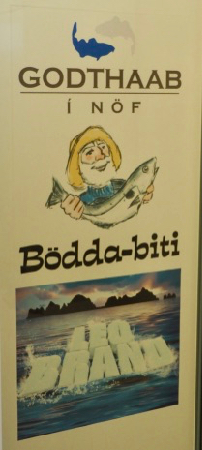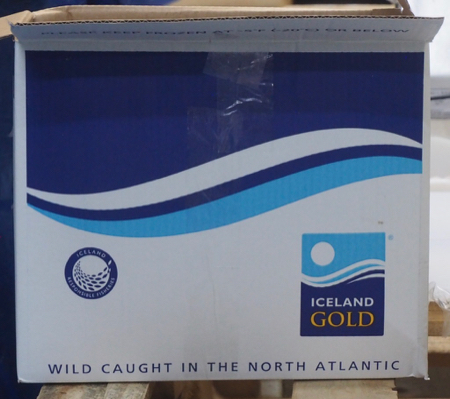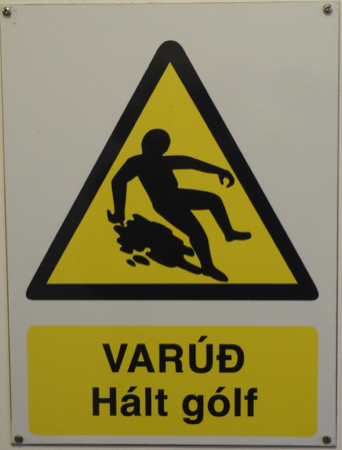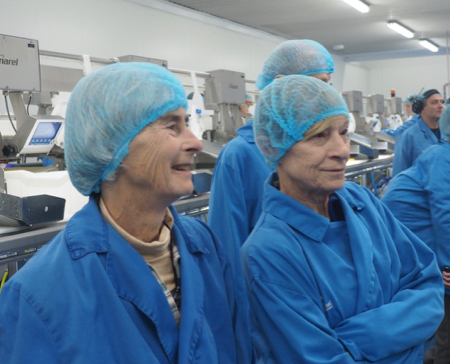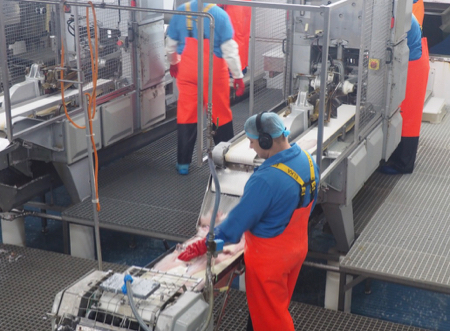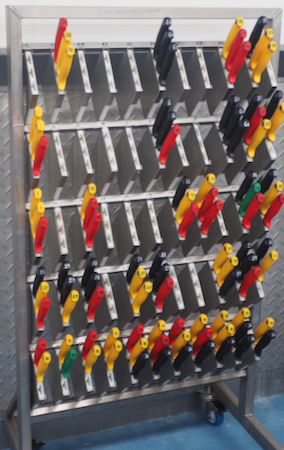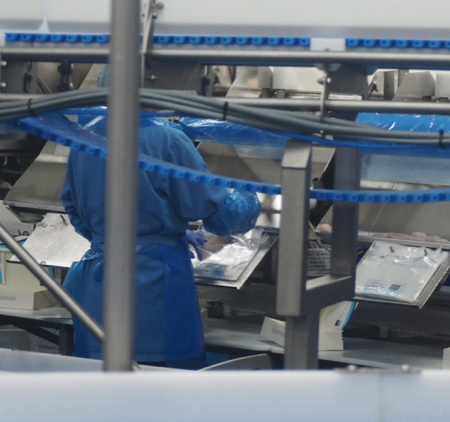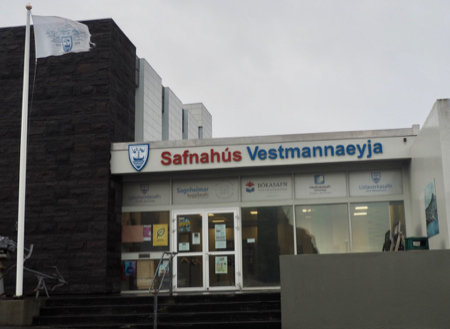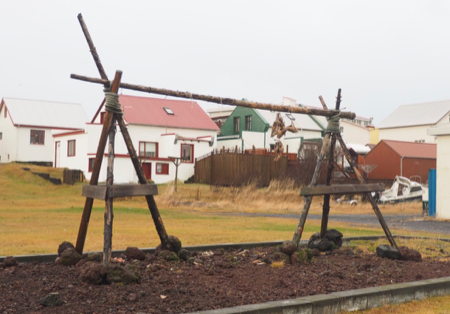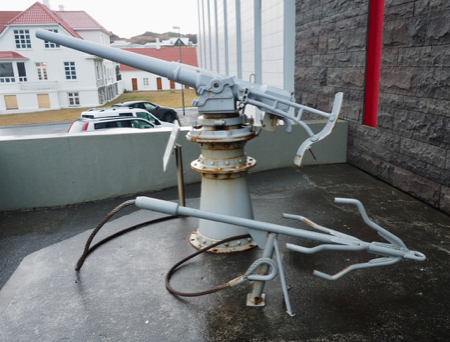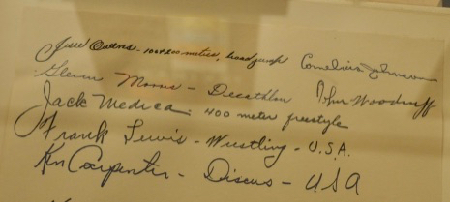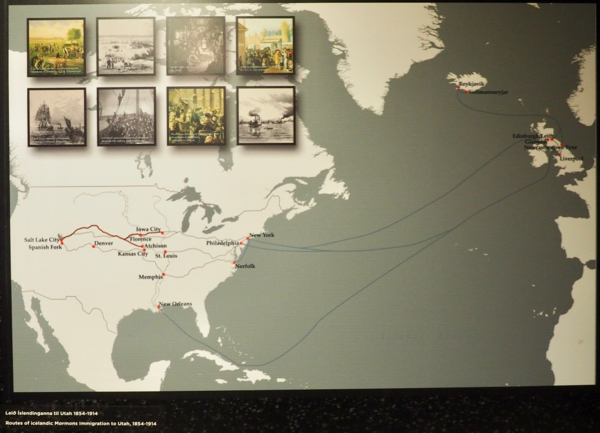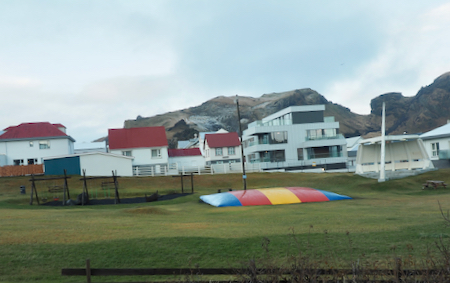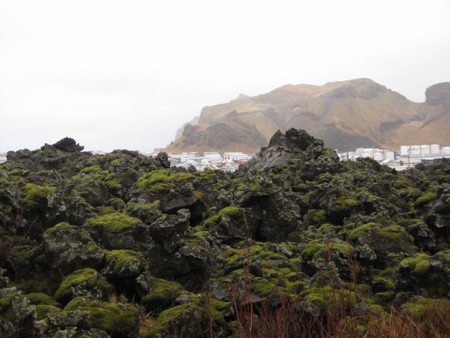Tues., 11/12/19 - Vestmannaeyjabær
This morning we walked across town to a large fish processing factory. On arrival, we hung up our jackets and put on booties, hair nets/caps, and cotton jackets to walk through the filleting room where three machines cut off the heads, filleted, and skinned the fish. The fish were already gutted on the trawler. The liver is removed and processed at a different site. The heads and bones are dried and sent to Nigeria and the skin is exported to Canada to make gelatin. Women cut the filets and another machine allows workers to put the them in plastic bags and boxes to be frozen and shipped. Most of the work is mechanized but workers sort and cut in what appears to be very monotonous work. Many workers are immigrants from Poland. We had the opportunity to taste liver, dried, and smoked fish.
The company - Godthaab Leo Brand - see their products - they look good enough to eat!
Package label
Graphic sign
What every well-dressed fish processor wears
The assembly line
Mostly automated, but not entirely
Knife rack
Fillets still have to be cut
Packaging
After the fish experience, we walked to the Sagnheimer Folk Museum, above the town library. The curator/owner gave us the tour. He was very proud of the local history. There was a section in the museum about the island’s 1973 volcanic eruption but we will get more of that later today when we visit the new museum.
Sagnheimer Folk Museum is above the Library
Fish-drying rack
Tools of the fishing trade
In 1936, four Icelanders were invited to compete at the Berlin Olympics in track and field. They were so awestricken upon entering the arena filled with cheering crowds, they did not do very well. They did, however, meet, and get the autograph of Jessie Owens and other champions. We looked at the autograph book and pictures of the athletes. Icelandic wrestlers were also invited as a showcase event for their unique style of wrestling. They hold a cord that is harnessed around the opponent's hips and fight with only their legs. Points are scored for certain moves or for putting the man on the ground.
Autographs from the 1936 Olympic Games
Iceland's athletes at the 1936 Olympic Games
The museum contains another section presenting information about two Icelanders who went to Denmark to learn trades and met some Mormon proselytizers. They became Mormons (baptized in 1851), returned to Iceland, and worked to grow the church's membership in Iceland. Early church members were encouraged to emigrate to the US where they could have a lot of land and several wives. They sailed to NY and walked 3,000 miles to Utah. The group of 16 who left Iceland in 1855 arrived in Salt Lake City and Brigham Young sent them to settle in Spanish Forks, Utah. Several of them returned to Iceland. One of those brought a violin with him that he had learned to play in Utah. He walked back to NY carrying the instrument under his arm. The violin was on display in the museum when a Hungarian violinist visited, asked to play it, and then asked if he could rent it because the quality was so perfect. The museum owners decided on a contract requiring him to return to the Westman Islands twice a year and play the violin for school children. He has done that and will be back on Nov. 22 to play again.
Route of the Icelandic Mormons to Spanish Forks, Utah
The museum contains information concerning the 1627 Turkish Raid of the Westmans and Iceland during which more than 400 were captured and taken into slavery in Algeria.
There was a wall of photos of sports teams, mostly soccer and team handball.
Another area contained furnishings typical of those found in settlers' homes.
In keeping with the main occupation of its residents, a large room was devoted to displays concerning fishing through the ages. Most interesting was the history of rubber life rafts and later safety equipment.
Altogether, this is an excellent small museum!
Playground
Street scene
The Ferry
Lava field with town beyond
Lunch today was at the harbor at a “Mexican” restaurant run by a Slovenian and a Czech. There were three soups, wonderful bread, and then the fixings for a burrito on a flour tortilla. It tasted very different from home. The guacamole and salsa were very different.
It rained hard all morning and harder after lunch, so Andres got us a shuttle ride up to the Eldheimer Volcano Museum. We watched a documentary film on the 1973 volcanic eruption that continued spewing materials for five months and buried one-third of this city in lava. The US ambassador to Iceland was able to get US ships to arrive with water canons to pour sea water on the hot, moving lava to stop its flow and create a barrier to save the harbor and more of the city's structures. The day before the nighttime eruption, the fishing fleet was in the harbor, due to a bad storm at sea, and they were able to safely evacuate all the people to the mainland (Reykjavik).
The museum is built around one house that was dug out of the pumice and is exhibited as it was buried. It is a powerful site showing the force of Mother nature.
Harbor entrance
Lava
The day ended with another home hosted meal. The menu included a Greek appetizer of naan bread (the host is a baker) with tzatziki and pesto, pan fried fish, coleslaw with fruit and no mayonnaise, mashed potatoes with black olives and parmesan, and butter/onion sauce instead of gravy. Dessert was an American brownie with Icelandic whipped cream and strawberry sauce. After dinner our hosts sang folk songs from the '60s and '70s accompanied with a guitar and drum - they were hippies in their youth.
| Return to Top | Return to Itinerary | Return to Trips page to view other trips | Return to Dreamcatcher Home Page |
